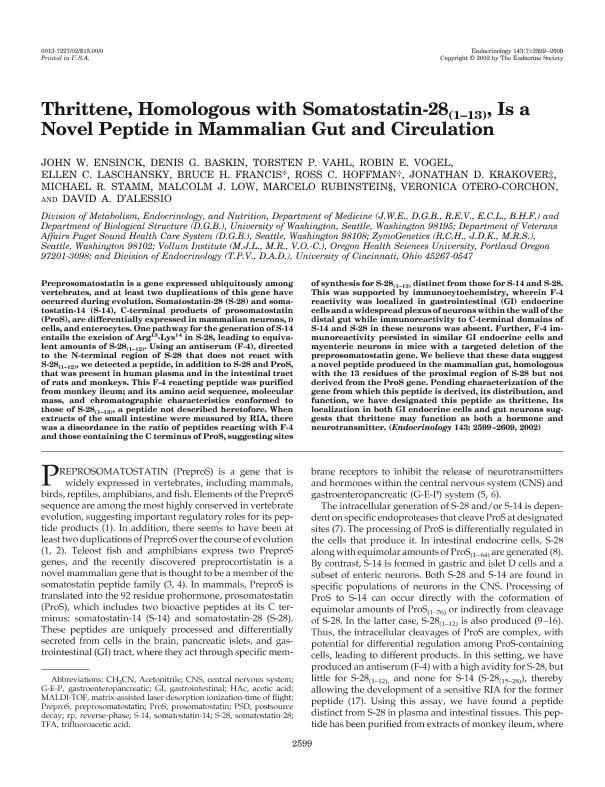Mostrar el registro sencillo del ítem
dc.contributor.author
Ensinck, John W.
dc.contributor.author
Baskin, Denis G.
dc.contributor.author
Vahl, Torsten P.
dc.contributor.author
Vogel, Robin E.
dc.contributor.author
Laschansky, Ellen C.
dc.contributor.author
Francis, Bruce H.
dc.contributor.author
Hoffman, Ross C.
dc.contributor.author
Krakover, Jonathan D.
dc.contributor.author
Stamm, Michael R.
dc.contributor.author
Low, Malcolm J.

dc.contributor.author
Rubinstein, Marcelo

dc.contributor.author
Otero Corchon, Veronica

dc.contributor.author
D'Alessio, David A.
dc.date.available
2019-07-18T19:05:21Z
dc.date.issued
2002-07
dc.identifier.citation
Ensinck, John W.; Baskin, Denis G.; Vahl, Torsten P.; Vogel, Robin E.; Laschansky, Ellen C.; et al.; Thrittene, homologous with somatostatin-28(1-13), is a novel peptide in mammalian gut and circulation; Oxford University Press; Endocrinology; 143; 7; 7-2002; 2599-2609
dc.identifier.issn
0013-7227
dc.identifier.uri
http://hdl.handle.net/11336/79827
dc.description.abstract
Preprosomatostatin is a gene expressed ubiquitously among vertebrates, and at least two duplications of this gene have occurred during evolution. Somatostatin-28 (S-28) and somatostatin-14 (S-14), C-terminal products of prosomatostatin (ProS), are differentially expressed in mammalian neurons, D cells, and enterocytes. One pathway for the generation of S-14 entails the excision of Arg13-Lys14 in S-28, leading to equivalent amounts of S-28(1-12). Using an antiserum (F-4), directed to the N-terminal region of S-28 that does not react with S-28(1-12), we detected a peptide, in addition to S-28 and ProS, that was present in human plasma and in the intestinal tract of rats and monkeys. This F-4 reacting peptide was purified from monkey ileum; and its amino acid sequence, molecular mass, and chromatographic characteristics conformed to those of S-28(1-13), a peptide not described heretofore. When extracts of the small intestine were measured by RIA, there was a discordance in the ratio of peptides reacting with F-4 and those containing the C terminus of ProS, suggesting sites of synthesis for S-28(1-13) distinct from those for S-14 and S-28. This was supported by immunocytochemistry, wherein F-4 reactivity was localized in gastrointestinal (GI) endocrine cells and a widespread plexus of neurons within the wall of the distal gut while immunoreactivity to C-terminal domains of S-14 and S-28 in these neurons was absent. Further, F-4 immunoreactivity persisted in similar GI endocrine cells and myenteric neurons in mice with a targeted deletion of the preprosomatostatin gene. We believe that these data suggest a novel peptide produced in the mammalian gut, homologous with the 13 residues of the proximal region of S-28 but not derived from the Pros gene. Pending characterization of the gene from which this peptide is derived, its distribution, and function, we have designated this peptide as thrittene. Its localization in both GI endocrine cells and gut neurons suggests that thrittene may function as both a hormone and neurotransmitter.
dc.format
application/pdf
dc.language.iso
eng
dc.publisher
Oxford University Press

dc.rights
info:eu-repo/semantics/openAccess
dc.rights.uri
https://creativecommons.org/licenses/by-nc-sa/2.5/ar/
dc.subject
Somatostatina
dc.subject.classification
Neurociencias

dc.subject.classification
Medicina Básica

dc.subject.classification
CIENCIAS MÉDICAS Y DE LA SALUD

dc.title
Thrittene, homologous with somatostatin-28(1-13), is a novel peptide in mammalian gut and circulation
dc.type
info:eu-repo/semantics/article
dc.type
info:ar-repo/semantics/artículo
dc.type
info:eu-repo/semantics/publishedVersion
dc.date.updated
2019-07-16T14:13:11Z
dc.journal.volume
143
dc.journal.number
7
dc.journal.pagination
2599-2609
dc.journal.pais
Reino Unido

dc.journal.ciudad
Oxford
dc.description.fil
Fil: Ensinck, John W.. University of Washington; Estados Unidos
dc.description.fil
Fil: Baskin, Denis G.. University of Washington; Estados Unidos. Department of Veterans Affairs Puget Sound Health Care System; Estados Unidos
dc.description.fil
Fil: Vahl, Torsten P.. University of Cincinnati; Estados Unidos
dc.description.fil
Fil: Vogel, Robin E.. University of Washington; Estados Unidos
dc.description.fil
Fil: Laschansky, Ellen C.. University of Washington; Estados Unidos
dc.description.fil
Fil: Francis, Bruce H.. University of Washington; Estados Unidos
dc.description.fil
Fil: Hoffman, Ross C.. ZymoGenetics; Estados Unidos
dc.description.fil
Fil: Krakover, Jonathan D.. ZymoGenetics; Estados Unidos
dc.description.fil
Fil: Stamm, Michael R.. ZymoGenetics; Estados Unidos
dc.description.fil
Fil: Low, Malcolm J.. Oregon Health Sciences University; Estados Unidos
dc.description.fil
Fil: Rubinstein, Marcelo. Oregon Health Sciences University; Estados Unidos. Consejo Nacional de Investigaciones Científicas y Técnicas. Instituto de Investigaciones en Ingeniería Genética y Biología Molecular "Dr. Héctor N. Torres"; Argentina
dc.description.fil
Fil: Otero Corchon, Veronica. Oregon Health Sciences University; Estados Unidos
dc.description.fil
Fil: D'Alessio, David A.. University of Cincinnati; Estados Unidos
dc.journal.title
Endocrinology

dc.relation.alternativeid
info:eu-repo/semantics/altIdentifier/doi/http://dx.doi.org/10.1210/endo.143.7.8904
dc.relation.alternativeid
info:eu-repo/semantics/altIdentifier/url/https://www.ncbi.nlm.nih.gov/pubmed/12072392
dc.relation.alternativeid
info:eu-repo/semantics/altIdentifier/url/https://academic.oup.com/endo/article/143/7/2599/2989507
Archivos asociados
